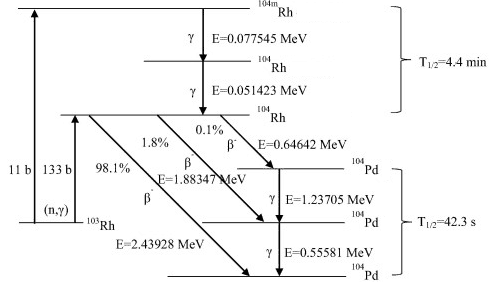 Self-Powered Neutron Detectors (SPND) are neutron detectors widely used in reactors to monitor neutron flux due to their adaptability for in-core severe environments. SPNDs may be a part of the incore neutron flux monitoring system, which provides detailed information on neutron flux distribution and thus the margins to these peak power limits. These detectors use its neutron activation material’s basic radioactive decay process to produce an output signal. As the name implies, SPNDs do not require an external voltage source to create a voltage potential in the detector. Instead, a current is produced in the detector as the result of neutron activation and subsequent beta decay of the detector itself. Because of the emission of these beta particles (electrons), the wire becomes more and more positively charged. The positive potential of the wire causes a current to flow in the resistor, R. The electron current from beta decay can be measured directly with an ammeter.
Self-Powered Neutron Detectors (SPND) are neutron detectors widely used in reactors to monitor neutron flux due to their adaptability for in-core severe environments. SPNDs may be a part of the incore neutron flux monitoring system, which provides detailed information on neutron flux distribution and thus the margins to these peak power limits. These detectors use its neutron activation material’s basic radioactive decay process to produce an output signal. As the name implies, SPNDs do not require an external voltage source to create a voltage potential in the detector. Instead, a current is produced in the detector as the result of neutron activation and subsequent beta decay of the detector itself. Because of the emission of these beta particles (electrons), the wire becomes more and more positively charged. The positive potential of the wire causes a current to flow in the resistor, R. The electron current from beta decay can be measured directly with an ammeter.
Advantages of SPNDs
There are two main advantages of the self-powered neutron detector:
- Very little instrumentation is required, usually only a millivoltmeter or an ammeter
- The emitter material has a much greater lifetime than boron or uranium-235 lining used in fission chambers.
Disadvantages of SPNDs
On the other hand, there are also disadvantages, and one is associated with the fact that currents, even at full power operation, are very low. Therefore, SPNDs cannot provide information about flux distribution at low power operation (10% and less). The main disadvantage of the self-powered neutron detector is that the emitter material decays with a characteristic half-life, which determines the detector’s response time.
Special Reference: William H. Todt, Sr. CHARACTERISTICS OF SELF-POWERED NEUTRON DETECTORS USED IN POWER REACTORS. Imaging and Sensing Technology Corporation. New York.